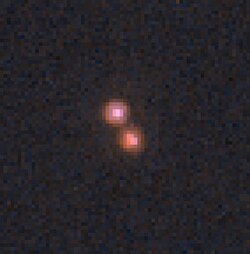DENIS-P J020529.0−115925 is a brown dwarf system in the constellation of Cetus. It is located 64 light-years (19.8 parsecs) away, based on the system's parallax.[4] It was first found in the Deep Near Infrared Survey of the Southern Sky.
 DENIS-P J020529.0−115925 system with Hubble, the primary A is on the upper left Credit: Hubble Space Telescope | |
| Observation data Epoch J2000 Equinox J2000 | |
|---|---|
| Constellation | Cetus |
| Right ascension | 02h 05m 29.401s[1] |
| Declination | −11° 59′ 29.67″[1] |
| Characteristics | |
| Spectral type | L5.5 + L8 + T0[2] |
| Apparent magnitude (J) | 14.587[1] |
| Astrometry | |
| Proper motion (μ) | RA: 427[3] mas/yr Dec.: 52[3] mas/yr |
| Parallax (π) | 50.60 ± 1.50 mas[4] |
| Distance | 64 ± 2 ly (19.8 ± 0.6 pc) |
| Other designations | |
| Database references | |
| SIMBAD | data |
This is a triple brown dwarf system: objects that do not have enough mass to fuse hydrogen like stars. The two brightest components, designated A and B respectively, are both L-type objects. As of 2003, the two were separated 0.287° along a position angle of 246°.[2]
Component B was observed as elongated, suggesting a third component. This third component, named C, is a T-type object.[2] It is separated about 1.9 astronomical units (au) from B, and based on a total mass of 0.1 M☉, the two may orbit each other every 8 years.[2]
See also edit
References edit
- ^ a b c Cutri, Roc M.; Skrutskie, Michael F.; Van Dyk, Schuyler D.; Beichman, Charles A.; Carpenter, John M.; Chester, Thomas; Cambresy, Laurent; Evans, Tracey E.; Fowler, John W.; Gizis, John E.; Howard, Elizabeth V.; Huchra, John P.; Jarrett, Thomas H.; Kopan, Eugene L.; Kirkpatrick, J. Davy; Light, Robert M.; Marsh, Kenneth A.; McCallon, Howard L.; Schneider, Stephen E.; Stiening, Rae; Sykes, Matthew J.; Weinberg, Martin D.; Wheaton, William A.; Wheelock, Sherry L.; Zacarias, N. (2003). "VizieR Online Data Catalog: 2MASS All-Sky Catalog of Point Sources (Cutri+ 2003)". CDS/ADC Collection of Electronic Catalogues. 2246: II/246. Bibcode:2003yCat.2246....0C.
- ^ a b c d Bouy, H.; Martín, Eduardo L.; Brandner, W.; Bouvier, J. (2005). "A Possible Third Component in the L Dwarf Binary System DENIS-P J020529.0-115925 Discovered with the Hubble Space Telescope". The Astronomical Journal. 129 (1): 511–517. arXiv:astro-ph/0410226. Bibcode:2005AJ....129..511B. doi:10.1086/426559. S2CID 119336794.
- ^ a b Schmidt, Sarah J.; Cruz, Kelle L.; Bongiorno, Bethany J.; Liebert, James; Reid, I. Neill (2007). "Activity and Kinematics of Ultracool Dwarfs, Including an Amazing Flare Observation". The Astronomical Journal. 133 (5): 2258–2273. arXiv:astro-ph/0701055. Bibcode:2007AJ....133.2258S. doi:10.1086/512158. S2CID 4809362.
- ^ a b Dahn, C. C.; Harris, Hugh C.; Vrba, Frederick J.; Guetter, Harry H.; Canzian, Blaise; Henden, Arne A.; Levine, Stephen E.; Luginbuhl, Christian B.; Monet, Alice K. B.; Monet, David G.; Pier, Jeffrey R.; Stone, Ronald C.; Walker, Richard L.; Burgasser, Adam J.; Gizis, John E.; Kirkpatrick, J. Davy; Liebert, James; Reid, I. Neill (2002). "Astrometry and Photometry for Cool Dwarfs and Brown Dwarfs". The Astronomical Journal. 124 (2): 1170–1189. arXiv:astro-ph/0205050. Bibcode:2002AJ....124.1170D. doi:10.1086/341646. S2CID 119485007.